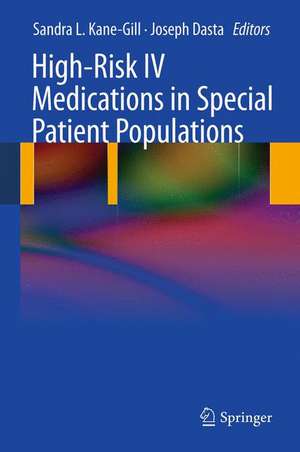High-Risk IV Medications in Special Patient Populations
Editat de Sandra Kane-Gill, Joseph Dastaen Limba Engleză Hardback – 29 iun 2011
| Toate formatele și edițiile | Preț | Express |
|---|---|---|
| Paperback (1) | 841.00 lei 6-8 săpt. | |
| SPRINGER LONDON – 15 aug 2014 | 841.00 lei 6-8 săpt. | |
| Hardback (1) | 712.46 lei 6-8 săpt. | |
| SPRINGER LONDON – 29 iun 2011 | 712.46 lei 6-8 săpt. |
Preț: 712.46 lei
Preț vechi: 749.95 lei
-5% Nou
Puncte Express: 1069
Preț estimativ în valută:
136.33€ • 142.34$ • 112.83£
136.33€ • 142.34$ • 112.83£
Carte tipărită la comandă
Livrare economică 04-18 aprilie
Preluare comenzi: 021 569.72.76
Specificații
ISBN-13: 9780857296054
ISBN-10: 0857296051
Pagini: 260
Ilustrații: X, 160 p.
Dimensiuni: 155 x 235 x 19 mm
Greutate: 0.34 kg
Ediția:2011
Editura: SPRINGER LONDON
Colecția Springer
Locul publicării:London, United Kingdom
ISBN-10: 0857296051
Pagini: 260
Ilustrații: X, 160 p.
Dimensiuni: 155 x 235 x 19 mm
Greutate: 0.34 kg
Ediția:2011
Editura: SPRINGER LONDON
Colecția Springer
Locul publicării:London, United Kingdom
Public țintă
Professional/practitionerCuprins
Anesthetic agents (general, inhaled, intravenous).- Propofol, ketamine, etc.- Anti-infectives.- aminoglycosides, vancomycin, drotrecogin, amphotericin products.- inhaled agents.- Anticoagulants agents.- unfractionated heparin, low molecular weight heparins, fondaparinux, lepirudin, argatroban, bivalrudin, abciximab, eptifibatide, tirofiban.- Thrombolytics –reteplase, tenecteplase, streptokinase, urokinase, alteplase.- Cardiac Drugs.- Adrenergic agents.- dopamine, dobutamine, vasopressin, , nitroglycerin, nitroprusside epinephrine, norepinepherine, phenylepherine.- Adrenergic antagonists.- Propranolol, diltiazem, verapamil, esmolol, labetalol, clevidipine.- Antidyrrhthmics.- amiodarone, lidocaine, procainamide.- Inotropic agents.- milrinone, amrinone, isoproterenol, niseritide, digoxin.- Prostanoids.- Epoprostenol, iloprost, treprostenil.- Electrolytes.- Potassium, magnesium, sodium chloride (hypertonic), cardioplegic solutions.- Hypoglycemics.- Insulin and oral agents.- Neuromuscular blocking agents .- vecuronium, rocuronium, cisatracurium, atracurium, succinylcholine.- Opioids (IV, oral).- Remifentanyl, fentanyl , morphine, hydromorphone, meperidine.- Sedatives (IV, oral and transdermal).- lorazepam, midazolam, diazepam, propofol, dexmedetomidine.- Information for Each Drug.- Propofol .- Normal.- Obese.- Renal Dysfunction.- CrCL.- Dialysis (HD, CRRT).- Liver Dysfunction.- Recommendations for Safe Use.
Recenzii
From the reviews:
“This book reviews the use of intravenous medications in patient populations with special considerations, discussing the dosing guidelines, safety concerns, and monitoring parameters. … It is intended for clinicians treating critically ill patients with high-risk intravenous medications. This is a good reference for doctors, nurses, pharmacists, and students in these disciplines to use to become well versed in the safe use of dangerous medications. … This is an excellent book that provides clear, concise information in a very usable format.” (Judith Klevan, Doody’s Review Service, November, 2011)
“This book reviews the use of intravenous medications in patient populations with special considerations, discussing the dosing guidelines, safety concerns, and monitoring parameters. … It is intended for clinicians treating critically ill patients with high-risk intravenous medications. This is a good reference for doctors, nurses, pharmacists, and students in these disciplines to use to become well versed in the safe use of dangerous medications. … This is an excellent book that provides clear, concise information in a very usable format.” (Judith Klevan, Doody’s Review Service, November, 2011)
Textul de pe ultima copertă
Critically ill patients are at risk for a higher frequency and severity of adverse drug events (ADEs), and special patient populations of the critically ill – requiring for instance individualized dosing due to non-average weight, hepatic or renal dysfunction, extracorporeal circulation devices, advanced age, pharmacogenetic alterations, hemodynamic instability, or therapeutic hypothermia – are particularly challenging. A contributing factor to this is the use of high-risk medications with many administered intravenously (IV). Hypervigilant monitoring of high-risk medications is still essential to prevent patient harm, especially in populations that have dosing challenges, hence, regulatory bodies internationally require active institutional surveillance of high-risk medications. These dosing challenges are a great safety concern, since there is considerable risk of unwanted adverse drug events from overdosing or therapeutic inefficacy from underdosing.
High-Risk IV Medications in Special Patient Populations reviews high-risk IV medication dosage considerations for special patient populations and discusses the safety concerns of these medications to aid the clinician in cautious monitoring. The authors provide clinicians with tools to minimize adverse drug events with IV high-risk medications, while maximizing the beneficial clinical effects of these drugs, thus making this book essential reading for all involved with the care of critically ill patients.
High-Risk IV Medications in Special Patient Populations reviews high-risk IV medication dosage considerations for special patient populations and discusses the safety concerns of these medications to aid the clinician in cautious monitoring. The authors provide clinicians with tools to minimize adverse drug events with IV high-risk medications, while maximizing the beneficial clinical effects of these drugs, thus making this book essential reading for all involved with the care of critically ill patients.
Caracteristici
The Institute for Safe Medication Practices has developed a list of high-alert medications which are medications at a heightened risk for patient harm when used in error No book has been published on this topic A resource containing all relevant information at a glance would be time-saving This resource will provide information to those who do not typically have access (community settings) Includes supplementary material: sn.pub/extras










